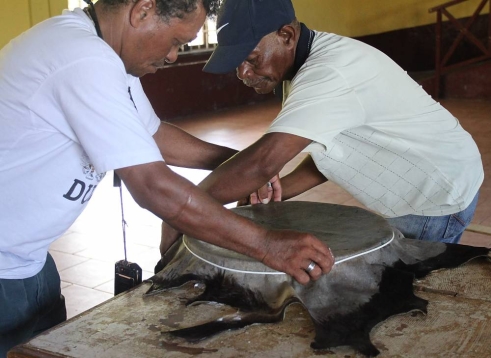UNESCO Chair in Living Heritage and Sustainable Livelihoods
Chaire UNESCO en Patrimoine vivant et les moyens de subsistances viables




Agnieszka Pawlowska-Mainville
Associate Professor,
Global and International Studies
UNESCO Chair

Kristin Catherwood
Heritage Saskatchewan
UNESCO Chair
Living heritage is at the core of who we are as individuals, families, and communities. The past lives through our sense of identity, belonging, and place. It shapes our worldviews and our lifeways. It carries intangible cultural heritage elements through generations and across time. With a firm grasp on how our living heritage informs the choices we make, we can create sustainable livelihoods together.
What we do
The purpose of the UNESCO Chair in Living Heritage and Sustainable Livelihoods is to promote an integrated system of research, teaching and training, as well as community engagement and communication in the area of Living Heritage/Intangible Cultural Heritage [ICH] and ICH-sourced livelihoods. We facilitate collaboration between organizations working in the area of [intangible] cultural heritage and high-level internationally recognized researchers, including faculty at UNBC and other academic institutions in Canada and other regions of the world.
The purpose of the UNESCO Chair in Living Heritage and Sustainable Livelihoods is to promote an integrated system of research, teaching and training, as well as community engagement and communication in the area of Living Heritage/Intangible Cultural Heritage [ICH] and ICH-sourced livelihoods. We facilitate collaboration between organizations working in the area of [intangible] cultural heritage and high-level internationally recognized researchers, including faculty at UNBC and other academic institutions in Canada and other regions of the world.
By using the spirit of the 2003 UNESCO Convention for the Safeguarding of Intangible Cultural Heritage, our specific objectives are to:
- recognize, promote, and safeguard intangible cultural heritage [ICH], also known as living heritage
- strengthen avenues for language acquisition, retention, transmission, and revitalization
- provide the conditions for the transmission of ICH through knowledge-exchange, ICH-driven pedagogies, creation and dissemination of best-practices, innovative use of digital technologies, youth mobility, and capacity-building
- collaborate with communities, organizations, NGOs, governments, Indigenous peoples, and the international community to support ICH-sourced livelihoods, including languages, through capacity building and self-determination over intangible cultural heritage elements
- bring intangible cultural heritage and sustainable economic pathways closer together, ensuring a balance between economic growth, socio-environmental well-being, and cultural resiliency
- cooperate closely with UNESCO, other UNESCO Chairs and UNITWIN Networks on relevant programs, workshops, and activities
Although Canada has not ratified the 2003 Convention, we are inspired by its principles and mechanisms and are working with practitioners and policy makers at all levels to instill the ‘spirit’ of the Convention in policy.

Figure 1. Timor Aid, Timor-Leste, 2016

Figure 2. Ministry of Culture of Peru, 2014

Figure 3. Mr Urny Mathiot, Seychelles, 2016
What is Intangible Cultural Heritage (ICH), otherwise referred to as Living Heritage?
The easiest way to understand ICH is to provide some ideas of what each word means on its own: Heritage is something that is passed down through generations or inherited from ancestors. Culture refers to dynamic characteristics such as values, traditions, identities, and languages that form a specific group identity. And intangible means impossible to touch, immaterial.
The easiest way to understand ICH is to provide some ideas of what each word means on its own: Heritage is something that is passed down through generations or inherited from ancestors. Culture refers to dynamic characteristics such as values, traditions, identities, and languages that form a specific group identity. And intangible means impossible to touch, immaterial.
 Figure 4. Performance throat singing, Avataq
Figure 4. Performance throat singing, AvataqBroad in scope, UNESCO’s 2003 convention on ICH characterizes this intentionally-vague definition of ‘intangible cultural heritage’ as “the practices, representations, expressions,knowledge, skills – as well as the instruments, objects, artifacts and cultural spaces associated therewith – that communities, groups and, in some cases, individuals recognize as part of their cultural heritage.” ICH includes traditions or living expressions inherited from our ancestors and passed on to our descendants. ICH is an essential ingredient for healthy communities and families, and for sustainable livelihoods. While fragile, intangible cultural heritage is an important factor in maintaining cultural diversity in the face of growing globalization.
UNESCO proposes five broad domains through which intangible cultural heritage is manifested. I have also provided several examples to illustrate the immense diversity of elements that can constitute a domain. The domains include,
UNESCO proposes five broad domains through which intangible cultural heritage is manifested. I have also provided several examples to illustrate the immense diversity of elements that can constitute a domain. The domains include,
- oral traditions and expressions, including language as a vehicle of the intangible cultural heritage
- the performing arts
- social practices, rituals, and festive events
- knowledge and practices concerning nature and the universe
- traditional artisanship and craftsmanship

Figure 5. Andrzej Janikowski/Historical
Museum of the city of Krakow (Poland), 2012
Cultural heritage goes beyond monuments and collections of objects; it can help bring ‘tangible’ heritage to life, rendering the two inexplicably linked. The importance of intangible cultural heritage is not the cultural manifestation itself but rather the wealth of knowledge and skills that is transmitted through it from one generation to the next.
- The heritage of humanity is richer and more diverse.
- Minorities and smaller communities are more healthy and resilient.
- We support activities that may be economically viable for craftspeople and communities.
- We improve our understanding of one another within and across communities.
- We are connected with the elements of our community histories and natural environments that help us understand who we are.
To be kept alive, intangible cultural heritage must be relevant to its community and transmitted from one generation to another –but given its fragility, it may need help from organizations, governments, and scholars from across the world. To be kept alive, intangible cultural heritage must be relevant to its community and transmitted from one generation to another –but given its fragility, it may need help from organizations, governments, and scholars from across the world. In Canada, local communities, non-governmental organizations, and provincial governments also have a role to play in creating policies that ensure the safeguarding of living heritage.
 Figure 6. K. Hejke, Poland 2019
Figure 6. K. Hejke, Poland 2019The first step in safeguarding intangible cultural heritage is to live it. Speaking to your children and nieces and nephews in your heritage language, learning it, engaging in cultural events and community-organized celebrations of culture, and speaking with knowledge-holders. The focus is on transmission, meaning, passing down ICH from generation to generation in a way that allows space for the natural evolution in our ways of doing and knowing.
Safeguarding also means raising awareness: making sure people understand what it is and why it deserves protection. Other important safeguarding techniques include inventorying or documentation, and research on best-practices.
Safeguarding also means raising awareness: making sure people understand what it is and why it deserves protection. Other important safeguarding techniques include inventorying or documentation, and research on best-practices.
Are you a student interested in the topic of cultural heritage?
Study with us and our partners through UNBC! Our UNESCO Chair network welcomes students interested in any area of research pertaining to intangible cultural heritage. Please look at our official UNESCO Chair website for an up-to-date and detailed list of projects we are currently working on and developing. Below are some general topics we are looking for student collaborators in:
Study with us and our partners through UNBC! Our UNESCO Chair network welcomes students interested in any area of research pertaining to intangible cultural heritage. Please look at our official UNESCO Chair website for an up-to-date and detailed list of projects we are currently working on and developing. Below are some general topics we are looking for student collaborators in:
- Research on issues in intangible cultural heritage in Canada: policymaking, gender, definitions, memory, cultural landscapes, access and ownership, intellectual property, war & peacekeeping, inventorying, safeguarding & transmission, the application of the 2003 UNESCO Convention, identity & well-being, ethics, food, music, performance & fine arts, knowledges, folklore, land-based traditions, and cultural traditions and practices from all over the world.
- Exploring the link between cultural heritage-economies and sustainable development
- Payments for ecosystem services related to land-based heritage
- At-risk heritage and the role of museums, NGOs, and governments
- Indigenous cultural heritages
- Language revitalization, language acquisition, language transmission, and linguistic education as well as linguicide and bilingualism (we are also interested in French-speaking students to assist with research across Canada)
- ICH education: creative pedagogies, storytelling, non-formal education, etc.
If you would like to learn more, check out some of our partner organizations and their work:
UNESCO Chair in Living Heritage and Sustainable Livelihoods (English)//
Chaire UNESCO en Patrimoine vivant et les moyens de subsistances viables (Français)
UNESCO List of Elements on the ICH List
Heritage Saskatchewan
Conseil québécois du patrimoine vivant (in French only)
Heritage NL
First Peoples Cultural Council
Carrier Linguistic Society
Cercles des Canadiens Français de Prince George
UNESCO Chair in Living Heritage and Sustainable Livelihoods (English)//
Chaire UNESCO en Patrimoine vivant et les moyens de subsistances viables (Français)
UNESCO List of Elements on the ICH List
Heritage Saskatchewan
Conseil québécois du patrimoine vivant (in French only)
Heritage NL
First Peoples Cultural Council
Carrier Linguistic Society
Cercles des Canadiens Français de Prince George

Figure 7. National Commission for Culture and the Arts, Philippines, 2020

Figure 8. Agency of Cultural Affairs (Japan), 2017

Figure 9. Victor Makashi, Department of Arts and Culture, Zambia, 2017
